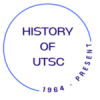The UTSC campus is physically located on banks of Highland Creek in the northeastern region of Toronto, the former municipality of Scarborough. The instructional and administration buildings sit high on a plateau overlooking Highland Creek and the lands in the valley below are home to sports playing fields and Miller Lash house (formerly a private home and later Principal’s residence – now a conference and meeting centre).
“We wish to acknowledge this sacred land on which the University of Toronto Scarborough operates. It has been a site of human activity for 15,000 years. This land is the territory of the Huron-Wendat and Petun First Nations, the Seneca, and most recently, the Mississaugas of the Credit River. The territory was the subject of the Dish With One Spoon Wampum Belt Covenant, an agreement between the Iroquois Confederacy and Confederacy of the Ojibwe and allied nations to peaceably share and care for the resources around the Great Lakes. Today, the meeting place of Toronto is still the home to many Indigenous people from across Turtle Island and we are grateful to have the opportunity to work in the community, on this territory.”
The above statement is a compilation of language first revised by the Elders Circle (Council of Aboriginal Initiatives) in 2014 and then further revised and adopted in 2016 by the University of Toronto in consultation with First Nations House and its Elders Circle, some scholars in the field, and senior University officials.
We believe that land acknowledgements are critical a step towards realizing our commitment to Truth and Reconciliation as a nation, as an institution and as individuals. And although the practice is often criticized as purely performative, we hope that through this public act of acknowledgment and our actions in this project to facilitate and co-create an historical narrative about this place will contribute in a small way to permanently uncovering what has been traditionally a hidden history. The stories told of this land and our connection to it are complex and we are committed to learning as much as we can about that complexity from stories and storytellers both within and outside our institution
